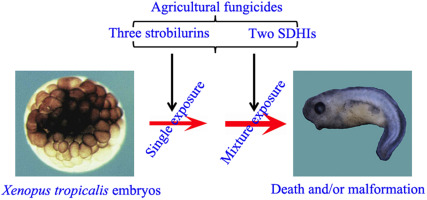Ecotoxicology and Environmental Safety ( IF 6.2 ) Pub Date : 2018-02-02 , DOI: 10.1016/j.ecoenv.2018.01.045 Siyu Wu , Lili Lei , Mengting Liu , Yang Song , Shibo Lu , Dan Li , Huahong Shi , Kathleen M. Raley-Susman , Defu He

|
The decline in amphibian populations is a critical threat to global biodiversity, and pesticide pollution is considered as one of the major factors. Although effects of single pesticides on amphibians have been documented, toxicological interactions prevailing in mixtures of pesticides have not been well elucidated. Strobilurin and succinate dehydrogenase inhibitor (SDHI) fungicides are new types of commonly used pesticides. In this study, effects of three strobilurins (pyraclostrobin, trifloxystrobin and azoxystrobin), two SDHIs (isopyrazam and bixafen), and their mixtures on X. tropicalis embryos were fully investigated. Results showed that exposure to individual fungicides induced lethal and teratogenetic effects; and malformed embryos displayed similar phenotypes including microcephaly, hypopigmentation, somite segmentation and narrow fin. Exposure to two strobilurins or two SDHIs at equitoxic concentrations caused additive or synergetic effects at environmentally relevant concentrations. TU for mixtures of isopyrazam and bixafen was 0.53 and 0.30 for lethal and teratogenic toxicity, respectively. Finally, binary mixtures of strobilurins and SDHIs also exhibited additive or synergetic effects on amphibian embryos. Overall, these results reveal that the mixtures of multiple fungicides caused a higher incidence of lethality and teratogenicity of amphibian embryos, compared to a single fungicide at the corresponding doses. Our findings provide important data about the ecotoxicology of agricultural fungicides on non-target organisms, which is useful for guiding management practices for pesticides.
中文翻译:

嗜球果伞素和SDHI杀菌剂对非洲爪蟾胚胎的单一和混合毒性
两栖动物数量的减少是对全球生物多样性的严重威胁,农药污染被视为主要因素之一。尽管已记录了单一农药对两栖动物的影响,但尚未充分阐明农药混合物中普遍存在的毒理学相互作用。伞形姜黄素和琥珀酸脱氢酶抑制剂(SDHI)杀菌剂是新型的常用农药。在这项研究中,三种嗜球果伞素(吡咯菌酯,三氟杀螨醇和嘧菌酯),两种SDHI(异比拉am和比沙芬)及其混合物对热带假单胞菌的影响对胚胎进行了充分的研究。结果表明,暴露于单独的杀菌剂会导致致死和致畸作用。畸形的胚胎表现出相似的表型,包括小头畸形,色素沉着,体节分割和窄鳍。在同等浓度下暴露于两种嗜球果伞菌素或两种SDHI中,在与环境有关的浓度下会产生累加或协同作用。异吡嗪和比沙芬混合物的致死毒性和致畸毒性的TU分别为0.53和0.30。最后,嗜球果伞素和SDHIs的二元混合物也对两栖动物胚胎表现出加性或协同作用。总体而言,这些结果表明,与相应剂量下的单一杀菌剂相比,多种杀菌剂的混合物导致两栖动物胚胎致死性和致畸性的发生率更高。


















































 京公网安备 11010802027423号
京公网安备 11010802027423号